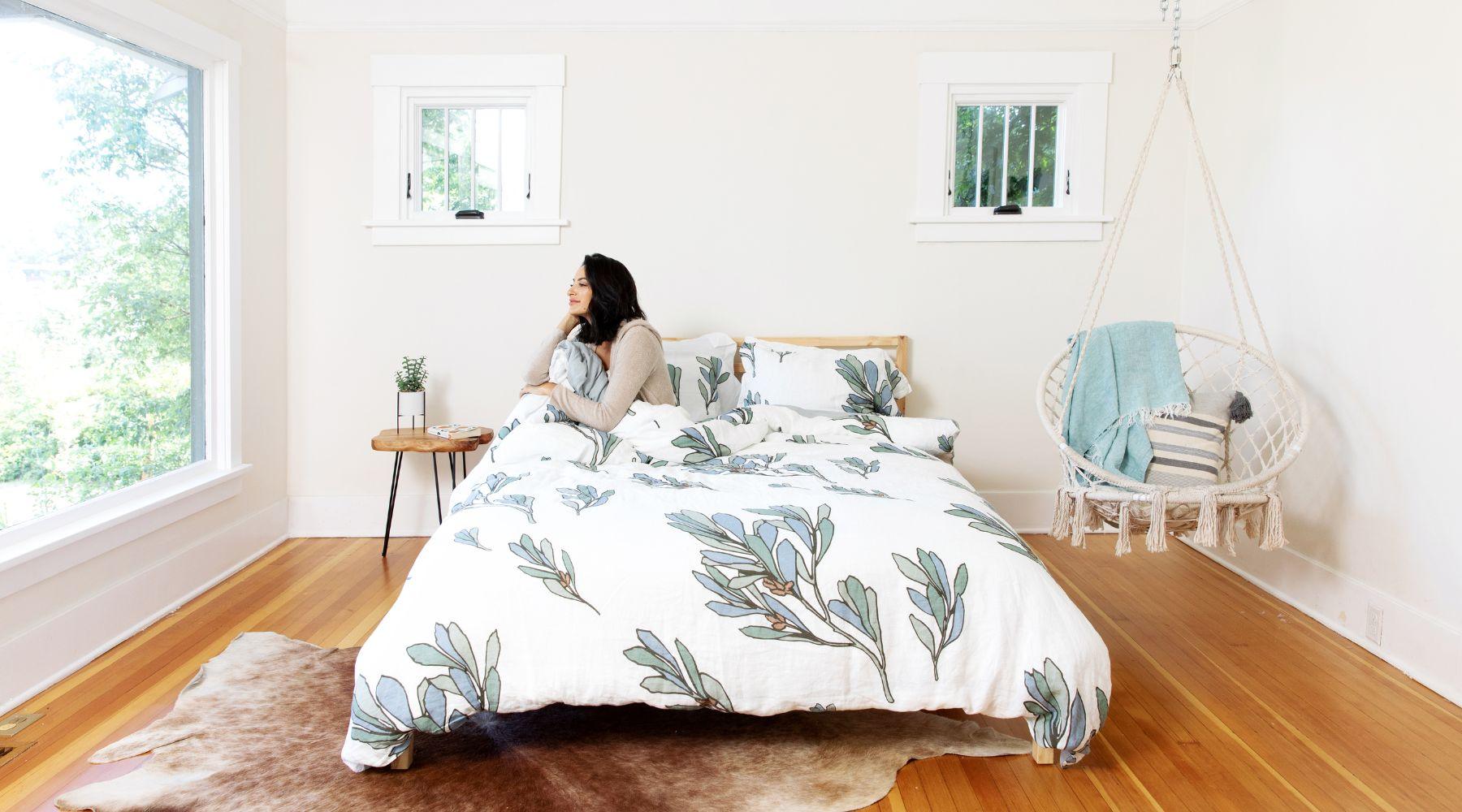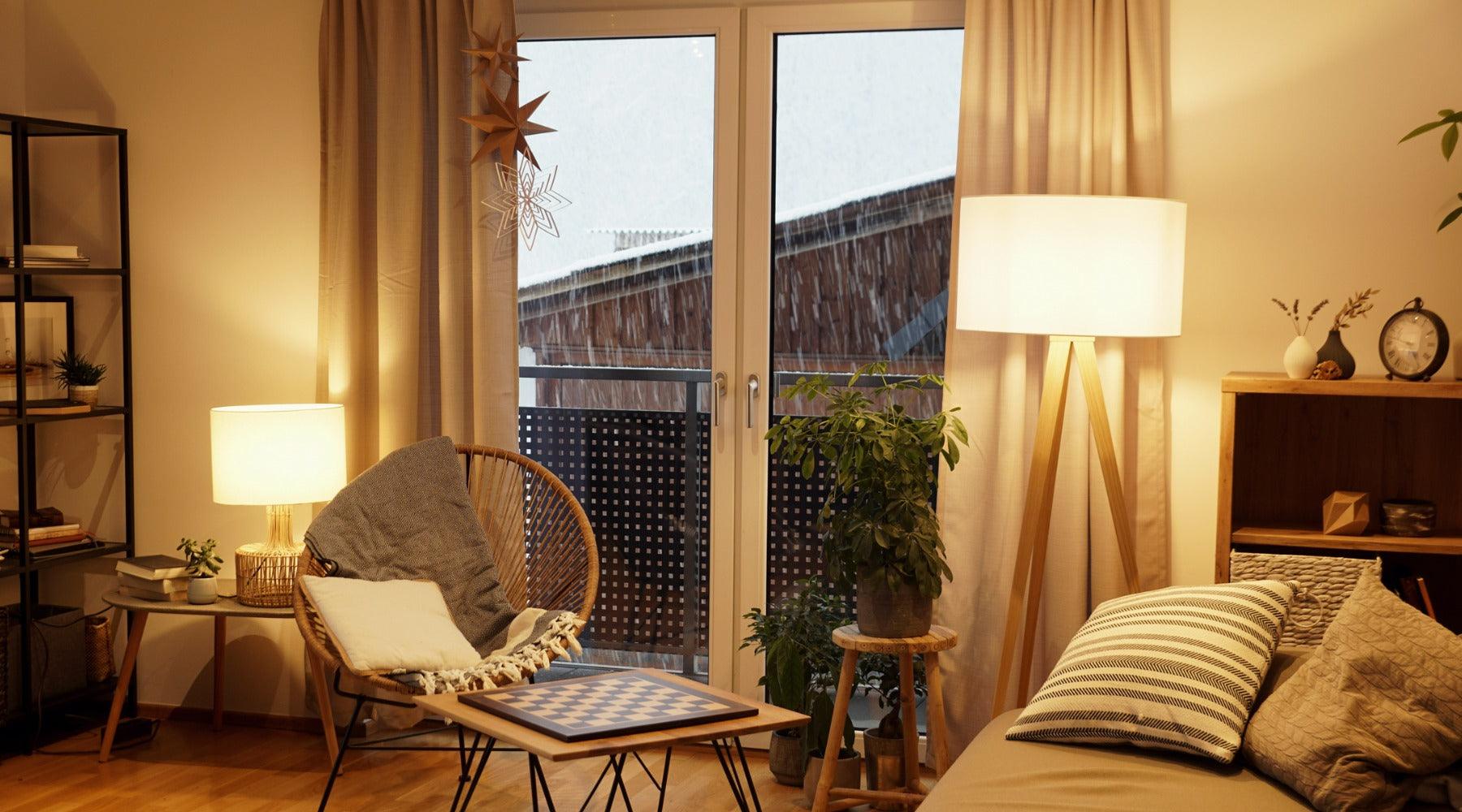
How to Decorate Your Scandi-Style Bed
Get tips for creating the perfect Scandinavian bed, from the frame to the bedding and everything in between (literally!).
The Frame
A sturdy bed frame is the essential foundation for a good night's sleep, something Scandinavians fully understand. In Norway, Sweden, and Denmark, you won't find hard, creaky metal frames on which you'll stub your toe in the night. Instead, you'll find minimalist frames in light woods such as pine, beech, and oak. Practically, these frames won't shake or creak; aesthetically, the natural materials create a calming atmosphere.
There's another advantage for space-strapped Scandinavians: under-bed storage. Choosing a bed frame with built-in storage creates the cleanest look. If you're already happy with your bed frame, buy under-bed rattan baskets, which look more attractive (and are more sustainable!) than plastic storage boxes.

Lately, tall and extravagant headboards have become all the rage in the United States—but on the other side of the Atlantic, you're unlikely to see one at all. If you do, it'll typically be low, unembellished, and made from the same wood as the rest of the frame. If your home has high ceilings and you've got a lot of wall space to fill, hang a (not too heavy!) painting over the bed instead of buying a high headboard.
The Mattress
The right mattress is a personal choice. There's no such thing as a "Scandi mattress"—the Scandinavian answer would be, simply, "the one that's most practical for you." Generally, softer mattresses are better for side sleepers, whereas firm mattresses are better for back and front sleepers.
The other main question is whether to go for memory foam or springs; each has advantages and disadvantages. Memory foam offers more support, as it molds to the contours of your body. It also isolates movement, so you're less likely to feel your partner getting up at night.
Spring mattresses have the advantage of better air circulation than memory foam, which lacks breathability. The best of both worlds is a hybrid mattress, with both springs and a memory foam layer—but they tend to be expensive.
Co-sleeping adds another layer of complication if each partner has different preferences. One solution is to buy a dual-tension mattress: one side is firm, the other soft. Another option is to buy two different twin mattresses and combine them on one king-size frame—note that with standard US sizes your mattresses will be slightly short, but you can cover the gap with a duvet or quilt. Some manufacturers make "split king" mattresses to address this problem.

The Floor
It may seem strange to address the floor in a blog post about beds—but the floor has an important role to play, too. If, like most Scandinavians, you favor a light-wood floor, then check for any creaks or squeaks that will wake up you or your partner if you get up in the night. The internet is packed with tips and tricks on how to fix this; this Better Homes & Gardens guide is a good place to start.
Another consideration for your floor is what sort of rug to use. Rugs have several advantages: they dampen sound and provide your feet with something cozy to sink into when you wake. The most common mistake people make with rugs is that they're too small. "Stylists usually recommend having either a large rug that extends 60-70cm (24-28in) on each side of the bed, or two shorter rugs, one on each side of the double bed," writes Swedish designer Frida Ramstedt in The Interior Design Handbook. For maximum coziness (and in keeping with the Scandi design style), pick a light-colored, deep-pile wool rug or sheepskin.
The Pillows
It's important to pick the right-sized pillow for your bed; standard size pillows can look comically small on a king-sized bed. Fortunately, The Modern Dane's Scandinavian-design bedding includes pillowcases in both standard and king sizes.
In terms of fill, feather and down pillows are luxurious and breathable but can cause neck issues if they compress too much in the night—this can be particularly problematic for side sleepers. A whole range of firmer down alternatives are now available—many of them made from recycled materials.
The Duvet(s)
Firstly: you need a duvet, not a comforter! The concept of a comforter and top sheet—with all its fuss and questionable hygiene—is completely foreign to Scandinavians, who favor practicality above all else. If you're constrained by budget, put your comforter in a duvet cover—just be aware that the sizing may be different. Regarding duvet fills, goose down is considered the gold standard, but there are many great vegan and hypoallergenic alternatives.
One unusual aspect of life in Scandinavian (and some central European) countries is that sleeping with two twin duvets is standard for couples sharing a bed. This is especially useful if one (or both) of you move a lot in the night, or one prefers a thicker duvet than the other. The main drawback of this approach is that it may look less attractive than one large duvet—if that's the case, drape a quilt over your duvets during the day so that your bed looks neat.
The Bedding
Being chemical-free, durable, and sustainable, organic linen bedding aligns with Scandinavian values in a way that cotton and other textiles simply don't. In addition, its thermoregulating properties work for both freezing Scandi winters and (admittedly short!) Scandi summers.
Aesthetically, organic linen duvet covers have a tactile, touchable texture that sits perfectly with other natural materials favored by Scandinavian designers. As you'll see in our store, they come in a range of solid colors, or Nordic-inspired prints if you prefer the bed to be the focal point of the room.
Do I Need Anything Else?
Scandinavian design's preference for minimalism means that you'll rarely find any throw pillows or layers—i.e. clutter—on Scandi beds. The beautiful design on your linen duvet covers—or simply their texture—is more than enough. Resist adding unnecessary pieces to your bed to let the essential elements shine through.
Which of our tips will you be putting into practice? Did anything surprise you about the difference between Scandinavian and American beds? Let us know on Instagram, Pinterest, Facebook or Twitter!







Leave a comment
This site is protected by hCaptcha and the hCaptcha Privacy Policy and Terms of Service apply.